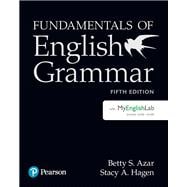Using a time-tested approach that has helped millions of students around the world, Fundamentals of English Grammar blends direct grammar instruction with carefully sequenced practice to developspeaking, writing, listening, and reading skills.
The fifth edition has been extensively revised to keep pace with advances in theory and practice, particularly from cognitive science. Now more than ever, teachers will find an extensive range of presentations, activities, and tasks to meet the specific needs of their classes.
New to This Edition
• A pretest at the start of each chapter allows learners to assess what they already know and
orient themselves to the chapter material.
• Practice, spaced out over time, helps students learn better. Numerous exercises have been
added to provide more incremental practice.
• New charts and exercises show patterns to help learners make sense of the information.
• Meaning-based practice is introduced at the sentence level. Students do not have to wait for
longer passages to work with meaning.
• Frequent oral exercises encourage students to speak more naturally and fluidly.
• Step-by-step writing activities promote written fluency. All end-of-chapter tasks include
writing tips and editing checklists.
• A wide range of contextualized exercises, frequently including life skills vocabulary,
encourages authentic language use.
• Updated grammar charts based on corpus research reflect current usage and highlight the
differences between written and spoken English in formal and informal contexts.
• The BlackBookBlog focuses on student success, cultural differences, and life-skills strategies.
• End-of-the-chapter Learning Checks help students assess their learning.
• A Pearson Practice English app with end-of-chapter learning checks, Student
Book audio, and guided PowerPoint videos.
• Revised MyEnglishLab for a fully blended program.








